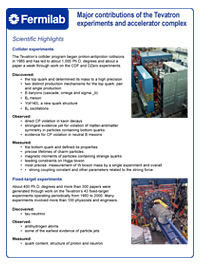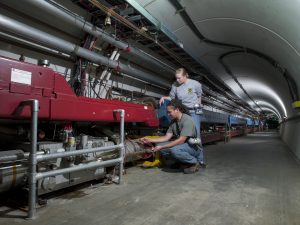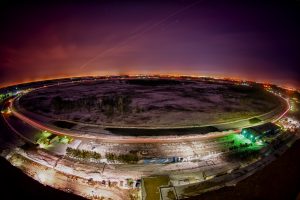The Tevatron will shut down at the end of September 2011 after 26 years of colliding particles. The two detector teams that utilize the Tevatron, CDF and DZero, will continue to analyze data and produce scientific papers at the same record-setting rate for the next couple of years and then at a slower rate for another two years.
The steadily increasing data sets at the Tevatron have boosted the number of papers submitted by the CDF and DZero collaborations collectively for publication in 2011 up from a life-time average of one a week. At a little more than six months through 2011, both collaborations have published more than 60 papers between them and are on track to publish more papers in a single year than any year in the history of the Tevatron experiments. The number of publications produced will grow through 2012 and beyond as scientists will use better analysis techniques to squeeze more information out of their unique data sets.
CDF and DZero explore the subatomic world to search for the origin of mass, extra dimensions of space and new particles that could explain the nature of our universe. Nearly 1,000 students have received Ph.D.s through their research at the Tevatron.
See this pdf to get highlights of discoveries and technological advances made possible by the Tevatron.
The shutdown process
The laboratory will celebrate the accomplishments of the Tevatron, its detectors and those who made and operate them with a ceremony Sept. 30. Media may have access in person or online to this event. Notifications will be made closer to Sept. 30.
When the Tevatron shuts down no one will do anything as dramatic as pull a plug. Accelerator operators will simply stop putting stores of protons and antiprotons into the Tevatron ring. The last store will be utilized until it’s collision per second rate drops below a useful level and then the remaining particles will be harmlessly diverted into a metal target that will absorb them. This is a routine process that has been used for annual maintenance shutdowns. Accelerator operators will then warm up the superconducting magnets in the accelerator tunnel for a few days to a week. After that, crews will slowly start removing the fluids and gases. That work should be finished by the end of December.
As for the detectors, CDF will have its fluids and gases removed within a month and be completely shut down. DZero will take about three months because the collaboration plans to take cosmic-ray data for a brief period to do a double-check of the calibration of its detector before fully shutting it down.
Tevatron
The 4-mile in circumference Tevatron accelerator uses superconducting magnets chilled to minus 450 degrees Fahrenheit, as cold as outer space, to move particles at nearly the speed of light.
The Tevatron typically produces about 10 million proton-antiproton collisions per second. Each collision produces hundreds of particles. About 200 collisions per second are recorded at each detector for further analysis.
As of July 2011, CDF has analyzed more than 8 inverse femtobarns of collision data while DZero has scrutinized up to 9 inverse femtobarns. The collaborations anticipate accumulating a total of 10 and 11 inverse femtobarns of data, respectively, by the time the Tevatron shuts down at the end of September. One inverse femtobarn represents about 50 trillion proton-antiproton collisions at the Tevatron.
CDF
The three-story, 6,000-ton CDF detector takes snapshots of the particles that emerge when protons and antiprotons collide. The CDF collaboration consists of about 500 members from 63 institutions in 15 countries.
DZero
Scientists measure the energy, momentum and electric charges of subatomic particles using a three-story assembly of sub detectors wrapped around DZero’s collision area like the layers of an onion. About 500 physicists from 90 institution in 18 countries work on DZero.
Main Control Room
Accelerator operators working 24-hours-a-day maintain a “sweet spot” level of protons and antiprotons and steer them through a chain of seven accelerators, culminating in the Tevatron ring, that increase the speed of the particles like gears on a car. The system creates and contains for the longest amount of time the most antimatter in the world.
Tevatron Milestone
January 1973
Fermilab establishes superconducting magnet R&D program
July 5, 1979
DOE authorizes Fermilab to build superconducting accelerator
March 18, 1983
Installation of the last of 774 superconducting magnets
Video
July 3, 1983
Tevatron accelerates protons to world record energy of 512 GeV
https://history.fnal.gov/lml_tevatron.html#saver
August 16, 1983
Groundbreaking for Antiproton Source
Video
October 1, 1983
Start of the Tevatron fixed-target program at 400 GeV with five fixed-target experiments
https://conferences.fnal.gov/tevft/book/SECTION9.htm
February 16, 1984
Acceleration of Tevatron beam to 800 GeV.
September 6, 1985
Fermilab accelerators produce and collect (“stack”) first antiprotons
October 13, 1985
First observation of proton-antiproton collisions by CDF collider detector
at 1.6 TeV (2 x 800 GeV)
Video
May 1986
Tevatron named one of the Top Ten Engineering Achievements of the Last 100 Years
October 21, 1986
Acceleration of Tevatron beam to 900 GeV
November 30, 1986
First proton-antiproton collisions at 1.8 TeV
October 18, 1989
President George Bush presents Helen Edwards, Dick Lundy, Rich Orr and Alvin Tollestrup with the National Medal of Technology for their work in building the Tevatron.
https://history.fnal.gov/wh_fermilab.html#1989
May 12, 1992
DZero collider detector observes first proton-antiproton collisions
https://d0server1.fnal.gov/projects/results/runi/highlights/highlight_document/Highlights_v18_final.pdf
August 31, 1992:
Collider Run I begins
September 27, 1993
Tevatron’s cryogenic cooling system is named International Historic Mechanical Engineering Landmark by the American Society of Mechanical Engineers
Video | Graphic
February 2, 1995
Tevatron sets world record for number of high-energy proton-antiproton particle collisions.
March 3, 1995
Experimenters of the CDF and DZero collaborations announce discovery of top quark.
Learn more | Video
February 20, 1996
End of Collider Run I. The Tevatron has delivered 180 inverse picobarns to both CDF and DZero.
Learn more | Video
November 18, 1996
Observation of antihydrogen atoms at Fermilab
Learn more | Video
August 5, 1997
The Tevatron delivers a record intensity 800 GeV beam for fixed-target experiments: 2.86E13.
March 5, 1998
Discovery of B-sub-c Meson, the last of the quark-antiquark pairs known to exist.
March 1, 1999
Observation of direct CP violation in the decay of neutral Kaons
January 2000
End of the Tevatron fixed-target program, which provided beam to 43 experiments
July 20, 2000
The DONuT experiment reports first evidence for the direct observation of the tau neutrino
March 1, 2001
Start of Tevatron Collider Run 2
July 16, 2004
Tevatron achieves a peak luminosity of 1E32 cm -2sec -1.
June 24, 2005:
Run 2 achieves one inverse femtobarn of integrated luminosity
July 9, 2005
First observation of electron cooling of antiprotons in the Recycler Ring
February 10, 2006
The Antiproton Source exceeds for the first time a stacking rate of 20 mA per hour
September 25, 2006
Discovery of B_s matter-antimatter oscillations: 3 trillion times per second
October 23, 2006
Discovery of Sigma-sub-b baryons (u-u-b and d-d-b)
January 7, 2007
CDF announces the most precise measurement of the W boson mass by a single experiment
June 2007
Discovery of the cascade-b baryon (down-strange-bottom combination)
March 17, 2008
The Tevatron achieves a peak luminosity in excess of 3E32 cm -2sec -1.
March 25, 2008
The Tevatron delivers 50 inverse picobarns in a single week
July 30, 2008
Observation of ZZ diboson production at the Tevatron
August 4, 2008
Tevatron experiments start restricting the allowed Higgs mass range
https://www.fnal.gov/pub/presspass/press_releases/Higgs-constraints-August2008.html
September 2008
Both CDF and DZero reach five inverse femtobarns of luminosity
March 9, 2009
Discovery of single top quark production
March 11, 2009
DZero announces the world’s best measurement of W boson mass
March 18, 2009:
Discovery of a new quark structure named Y(4140)
June 29, 2009
Discovery of the Omega-sub-b baryon
https://www.fnal.gov/pub/presspass/press_releases/CDF-Omega-observation.html
July 20, 2011
Discovery of the Xi-sub-b, a heavy relative of the neutron
https://www.fnal.gov/pub/presspass/press_releases/2011/CDF-Xi-sub-b-observation-20110720.html
Sept. 30, 2011
Tevatron produces final proton-antiproton collisions; experiments will have collected about 10 inverse femtobarns of data each; data analysis will continue for several years
https://www.fnal.gov/pub/presspass/press_releases/2011/Tevatron-Shutdown-20100726-images.html




























